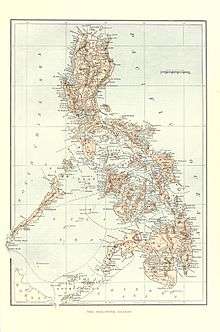Cainta (historical polity)
In early Philippine history, the Tagalog Bayan ("country" or "polity")[1] of Cainta (Filipino: Bayan ng Cainta; Kapampangan: Balen ning Cainta) was a fortified upriver polity which occupied both shores of an arm of the Pasig River. It was located not far from where the Pasig River meets the Lake of Ba-i, and is presumed to be the present site of the municipality of Cainta, Rizal.[2]
Description
Descriptions of early chroniclers say that it was surrounded by bamboo thickets, defended by a wall and several lantakas, and that an arm of the Pasig river flowed through the middle of the city, dividing it into two settlements.[2]
As described in the anonymous 1572 account documented in Volume 3 of Blair and Robertson's compiled translations:[2]
This said village had about a thousand inhabitants, and was surrounded by very tall and very dense bamboo thickets, and fortified with a wall and a few small culverins. The same river as that of Manilla circles around the village and a branch of it passes through the middle dividing it in two sections.
The Siege of Cainta (August 1571)
When the Spanish forces of Miguel López de Legazpi first established the City of Manila in 1571, Cainta was one of the surrounding polities who went to Manila to negotiate for friendship with Manila. However, Cainta's envoys noted the small size of Legaspi's forces and decided to withdraw their offer of friendship, since Cainta was a fortified polity which was perfectly capable of defending itself.[2]
In August 1571, Legazpi assigned his nephew, Juan de Salcedo, to "pacify" Cainta. After travelling several days upriver, Salcedo lay siege to the city, and eventually found a weak spot on the wall. The final Spanish attack over 400 residents of Cainta killed.[2]
Dissolution
It was established as a visita (annex) of Taytay on November 30, 1571, under the administration of the Jesuits.
See also
References
- ↑ "Pre-colonial Manila". Malacañang Presidential Museum and Library. Malacañang Presidential Museum and Library Araw ng Maynila Briefers. Presidential Communications Development and Strategic Planning Office. 23 June 2015. Archived from the original on 9 March 2016. Retrieved 27 April 2017.
- 1 2 3 4 5 Blair, Emma Helen; Robertson, James Alexander, eds. (1903). Relation of the Conquest of the Island of Luzon. The Philippine Islands, 1493-1898. 3. Ohio, Cleveland: Arthur H. Clark Company. p. 145.
